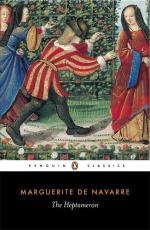1 OEuvres de Brantome, 8vo, vol. v. p. 222.
Margaret’s own letters supply proof of this. She is constantly to be found intervening in state affairs and exercising her influence. She receives the deputies from Basle, Berne, and Strasburg who came to Paris in 1537 to ask Francis I. for the release of the imprisoned Protestants. She joins the King at Valence when he is making preparations for a fresh war against Charles V.; then she visits Montmorency at the camp of Avignon, which she praises to her brother; next, hastening to Picardy, when the Flemish troops are invading it, she writes from Amiens and speaks of Therouenne and Boulogne, which she has found well fortified.
Francis, however, did not value her society and counsel solely for political reasons; he was also fond of conversing with her on literature, and at times they composed amatory verses together. According to an oft-repeated tradition, one day at the Chateau of Chambord, whilst Margaret was boasting to her brother of the superiority of womankind in matters of love, the King took a diamond ring from his finger and wrote on one of the window panes this couplet:—
“Souvent femme varie, Bien fol est qui s’y fie.” (1)
Brantome, who declares that he saw the inscription, adds, however, that it consisted merely of three words, “Toute femme varie” (all women are fickle), inscribed in large letters at the side of the window. (2) He says nothing of any pane of glass (all window panes were then extremely small) or of a diamond having been used; (3) and in all probability Francis simply traced these words with a piece of chalk or charcoal on the side of one of the deep embrasures, which are still to be seen in the windows of the chateau.
1 “Woman is often
fickle,
Crazy indeed is he who
trusts her.”
2 Vies des Dames galantes, Disc. iv.
3 The practice of cutting glass with diamonds does not seem to have been resorted to until the close of the sixteenth century. See Les Subtiles et Plaisantes Inventions de J. Prevost, Lyons, 1584, part i. pp. 30, 31.
Margaret carried her complaisance for her brother so far as to excuse his illicit amours, and she was usually on the best of terms with his favourites. (1) It has been asserted that improper relations existed between the brother and sister, but this charge rests solely upon an undated letter from her to Francis, which may be interpreted in a variety of ways. Count de la Ferriere, in his introduction to Margaret’s record of her expenditure, (2) expresses the opinion that it was penned in 1525, prior to her hasty departure from Spain; while M. Le Roux de Lincy assigns it to a later date, remarking that it was probably written during one of the frequent quarrels which arose between Margaret’s brother and her husband. However, they are both of opinion that the letter does not bear the interpretation which other writers have placed upon it. (3)




